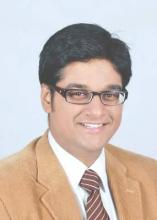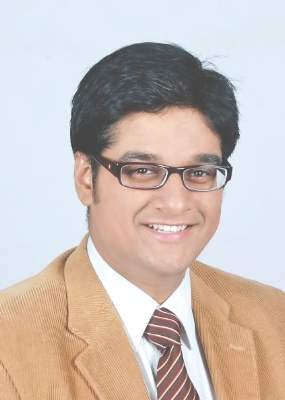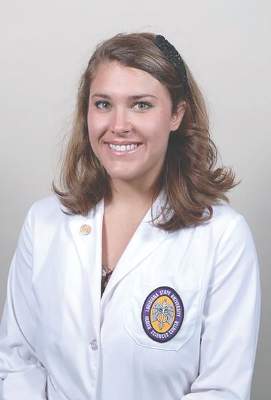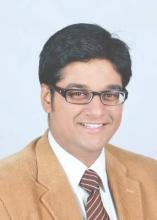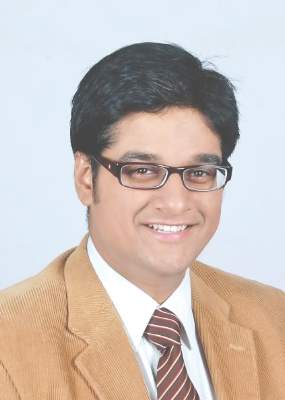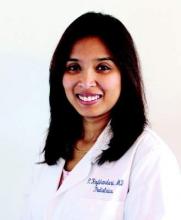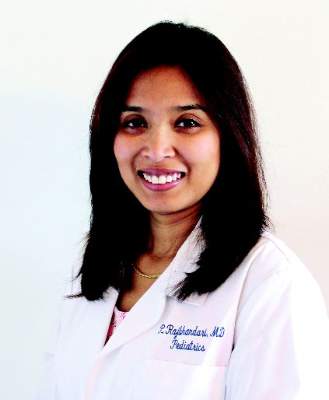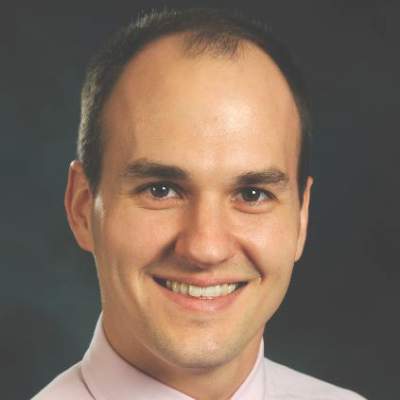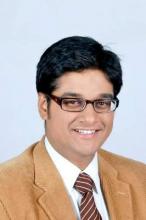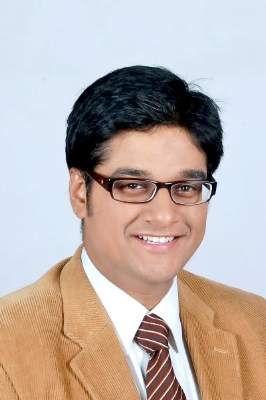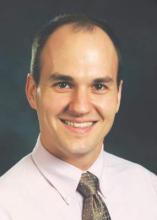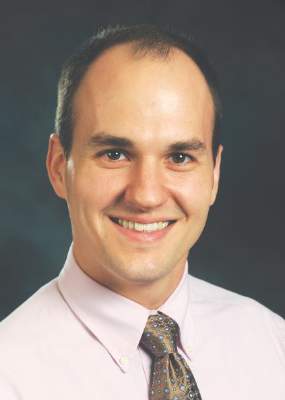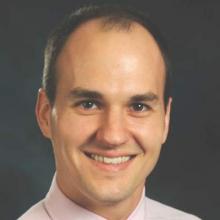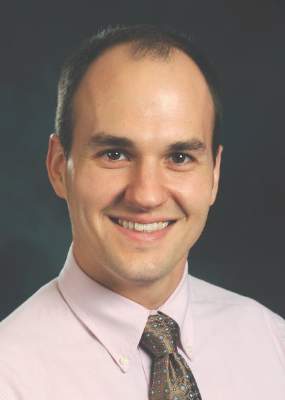User login
Wabi-sabi
Recently, I was amazed to see a small walk-in booth with a webcam, a monitor, and a curtain, offering telemedicine consults from the comfort of a service station on I-95. Pandora’s Box, I thought.
The robots are coming! Take a dip into popular science fiction if you don’t believe me. From Asimov to “Star Wars,” there are innumerable examples of aseptic, polite automatons providing prompt, unbiased, unfatigued medical care. People have always been enamored by such visions of the future. And booths like this are the gateway to that vision. As excited as I am about this tremendous advance and the potential it holds, I can’t help but feel that when this new frontier of medicine reaches fruition, we will have lost something, too.
Medical education is exacting, exciting, and at times, excruciating. But above all, the privileged experience of learning about the inner workings of the body is an innately human process. Looking back, it’s not syndromes, numbers, or dosages I remember, but the colorful spectrum of characters I encountered along the way. We’ve all met them – the funny, the quirky, the warm, the gentle, the stern, the phlegmatic, the intermittently explosive, the socially inept, the obliviously savant, and occasionally, the frankly sociopathic. They are the ones who teach us how the science of medicine connects with the art of healing. Our bedside manners and critical thinking processes are molded by the intercourse between the different types of personalities we encounter in our education.
Until the first Medibot 3000 is rolled out, doctors will be flawed, biased, and stressed humans. We deal with the same roller coaster journey through life as do our patients, but we accept a responsibility to be the caretakers of their health. Perhaps we do so not in spite of our faults, but all the better because of them. The human experience provides us with empathy. It ingrains within us unique insights and perspectives. It allows us to read between the lines of a patient’s statements. It pushes us to go beyond protocols when we need to, and it helps us create the trust that is the heart of the doctor-patient relationship.
Kintsugi is the Japanese art of fixing cracks along broken pottery with rare metals, thus creating unique and beautiful patterns which accentuate the character of the pot. It is part of a philosophy called wabi-sabi, which is all about embracing imperfection. I think they’re on to something there.
Patients are not vignettes. There is no peer-reviewed algorithm for being a good doctor. Not to say that these things are not important. They are crucial tools in our endeavor to improve our medical skills and knowledge – the bedrock upon which a career in medicine must be founded. But I hope that in our quest to improve outcomes, to remove suffering, and move toward the beckoning future, we still will have a place in medicine for human characteristics that define the act of healing, and for the philosophy of wabi-sabi. Bring the robots on, I say.
Dr. Behere was a pediatric resident at the Children’s Hospital at Dartmouth, Lebanon, New Hampshire, when he wrote this article. He is currently a first-year fellow in pediatric cardiology at the Nemours Cardiac Center at the Nemours/Alfred I. duPont Hospital for Children, Wilmington, Del. E-mail him at [email protected].
Recently, I was amazed to see a small walk-in booth with a webcam, a monitor, and a curtain, offering telemedicine consults from the comfort of a service station on I-95. Pandora’s Box, I thought.
The robots are coming! Take a dip into popular science fiction if you don’t believe me. From Asimov to “Star Wars,” there are innumerable examples of aseptic, polite automatons providing prompt, unbiased, unfatigued medical care. People have always been enamored by such visions of the future. And booths like this are the gateway to that vision. As excited as I am about this tremendous advance and the potential it holds, I can’t help but feel that when this new frontier of medicine reaches fruition, we will have lost something, too.
Medical education is exacting, exciting, and at times, excruciating. But above all, the privileged experience of learning about the inner workings of the body is an innately human process. Looking back, it’s not syndromes, numbers, or dosages I remember, but the colorful spectrum of characters I encountered along the way. We’ve all met them – the funny, the quirky, the warm, the gentle, the stern, the phlegmatic, the intermittently explosive, the socially inept, the obliviously savant, and occasionally, the frankly sociopathic. They are the ones who teach us how the science of medicine connects with the art of healing. Our bedside manners and critical thinking processes are molded by the intercourse between the different types of personalities we encounter in our education.
Until the first Medibot 3000 is rolled out, doctors will be flawed, biased, and stressed humans. We deal with the same roller coaster journey through life as do our patients, but we accept a responsibility to be the caretakers of their health. Perhaps we do so not in spite of our faults, but all the better because of them. The human experience provides us with empathy. It ingrains within us unique insights and perspectives. It allows us to read between the lines of a patient’s statements. It pushes us to go beyond protocols when we need to, and it helps us create the trust that is the heart of the doctor-patient relationship.
Kintsugi is the Japanese art of fixing cracks along broken pottery with rare metals, thus creating unique and beautiful patterns which accentuate the character of the pot. It is part of a philosophy called wabi-sabi, which is all about embracing imperfection. I think they’re on to something there.
Patients are not vignettes. There is no peer-reviewed algorithm for being a good doctor. Not to say that these things are not important. They are crucial tools in our endeavor to improve our medical skills and knowledge – the bedrock upon which a career in medicine must be founded. But I hope that in our quest to improve outcomes, to remove suffering, and move toward the beckoning future, we still will have a place in medicine for human characteristics that define the act of healing, and for the philosophy of wabi-sabi. Bring the robots on, I say.
Dr. Behere was a pediatric resident at the Children’s Hospital at Dartmouth, Lebanon, New Hampshire, when he wrote this article. He is currently a first-year fellow in pediatric cardiology at the Nemours Cardiac Center at the Nemours/Alfred I. duPont Hospital for Children, Wilmington, Del. E-mail him at [email protected].
Recently, I was amazed to see a small walk-in booth with a webcam, a monitor, and a curtain, offering telemedicine consults from the comfort of a service station on I-95. Pandora’s Box, I thought.
The robots are coming! Take a dip into popular science fiction if you don’t believe me. From Asimov to “Star Wars,” there are innumerable examples of aseptic, polite automatons providing prompt, unbiased, unfatigued medical care. People have always been enamored by such visions of the future. And booths like this are the gateway to that vision. As excited as I am about this tremendous advance and the potential it holds, I can’t help but feel that when this new frontier of medicine reaches fruition, we will have lost something, too.
Medical education is exacting, exciting, and at times, excruciating. But above all, the privileged experience of learning about the inner workings of the body is an innately human process. Looking back, it’s not syndromes, numbers, or dosages I remember, but the colorful spectrum of characters I encountered along the way. We’ve all met them – the funny, the quirky, the warm, the gentle, the stern, the phlegmatic, the intermittently explosive, the socially inept, the obliviously savant, and occasionally, the frankly sociopathic. They are the ones who teach us how the science of medicine connects with the art of healing. Our bedside manners and critical thinking processes are molded by the intercourse between the different types of personalities we encounter in our education.
Until the first Medibot 3000 is rolled out, doctors will be flawed, biased, and stressed humans. We deal with the same roller coaster journey through life as do our patients, but we accept a responsibility to be the caretakers of their health. Perhaps we do so not in spite of our faults, but all the better because of them. The human experience provides us with empathy. It ingrains within us unique insights and perspectives. It allows us to read between the lines of a patient’s statements. It pushes us to go beyond protocols when we need to, and it helps us create the trust that is the heart of the doctor-patient relationship.
Kintsugi is the Japanese art of fixing cracks along broken pottery with rare metals, thus creating unique and beautiful patterns which accentuate the character of the pot. It is part of a philosophy called wabi-sabi, which is all about embracing imperfection. I think they’re on to something there.
Patients are not vignettes. There is no peer-reviewed algorithm for being a good doctor. Not to say that these things are not important. They are crucial tools in our endeavor to improve our medical skills and knowledge – the bedrock upon which a career in medicine must be founded. But I hope that in our quest to improve outcomes, to remove suffering, and move toward the beckoning future, we still will have a place in medicine for human characteristics that define the act of healing, and for the philosophy of wabi-sabi. Bring the robots on, I say.
Dr. Behere was a pediatric resident at the Children’s Hospital at Dartmouth, Lebanon, New Hampshire, when he wrote this article. He is currently a first-year fellow in pediatric cardiology at the Nemours Cardiac Center at the Nemours/Alfred I. duPont Hospital for Children, Wilmington, Del. E-mail him at [email protected].
Death and dying
Learning about death and dying in residency is perhaps one of the hardest things about being a doctor. ... This list might make it a tiny bit easier.
1. The Hippocratic oath challenges us to be teachers not only to students, but also to our patients – especially to our dying patients. Remember you are teachers.
2. Nurses spend the most time with your patients; utilize them and learn from them. Nurses will make you better teachers and physicians.
3. When a patient is dying, hold that person’s hand if family isn’t around. Touch your patient.
4. Accompany your residents, fellows, or attending physicians to deliver bad news.
5. Ask to debrief after a patient dies.
6. While discussing treatment or prognosis with families, pay attention to the emotional data in the room. Tears should prompt tissues or hand holding. A wrinkled forehead or fearful face warrants a pause in conversation for the family to absorb the content. Tears don’t mean to hurry.
7. Attempt to understand your patient’s expectations. In other words, learn what the family’s goals are for treatment.
8. When a patient dies, reflect upon it in moderation. Don’t just move on to the next task. It’s okay to feel and to grieve … you are human.
9. When families declare DNR [do not resuscitate], don’t ask them repeatedly if they are sure. Also, make certain that they know they can change their minds at any time. Respect a patient’s values and wishes.
10. Take the time to have the difficult conversations early in diagnosis so families know what to expect. This empowers decisions that are proactive as opposed to reactive. Be proactive in your role as a teacher.
11. When discussing options, talk about what you CAN do before you talk about what you CAN’T do.
12. Withdrawing treatment and forgoing treatment are the same thing ethically and legally, but not emotionally.
13. When your patient is actively dying, see it out. Stay with the family, even if it’s time to go home.
14. When the family prays, be present.
15. Palliative care is neither hospice nor social work.
16. Ask your dying patients if they are afraid of anything – if the moment presents itself. Answer questions about death or find someone who can answer their questions.
17. No patient should die in pain. The doctrine of double effect allows a caregiver to provide medication for pain even though it may hasten death.
18. For the dying child, ask the family where they want their child to die. Don’t assume the family wants the death of their child to be at home or in the hospital. Ask.
19. Transitioning from treatment-oriented management to comfort care does not ever mean “there is nothing we can do.”
20. Lastly, and most importantly, I leave you with a question that should be in the back of our minds regarding quality of life and treatment options: Just because we can, should we?
Dr. Morvant is a second-year pediatric resident at Monroe Carell Jr. Children’s Hospital at Vanderbilt, Nashville, Tenn. E-mail her at [email protected].
Learning about death and dying in residency is perhaps one of the hardest things about being a doctor. ... This list might make it a tiny bit easier.
1. The Hippocratic oath challenges us to be teachers not only to students, but also to our patients – especially to our dying patients. Remember you are teachers.
2. Nurses spend the most time with your patients; utilize them and learn from them. Nurses will make you better teachers and physicians.
3. When a patient is dying, hold that person’s hand if family isn’t around. Touch your patient.
4. Accompany your residents, fellows, or attending physicians to deliver bad news.
5. Ask to debrief after a patient dies.
6. While discussing treatment or prognosis with families, pay attention to the emotional data in the room. Tears should prompt tissues or hand holding. A wrinkled forehead or fearful face warrants a pause in conversation for the family to absorb the content. Tears don’t mean to hurry.
7. Attempt to understand your patient’s expectations. In other words, learn what the family’s goals are for treatment.
8. When a patient dies, reflect upon it in moderation. Don’t just move on to the next task. It’s okay to feel and to grieve … you are human.
9. When families declare DNR [do not resuscitate], don’t ask them repeatedly if they are sure. Also, make certain that they know they can change their minds at any time. Respect a patient’s values and wishes.
10. Take the time to have the difficult conversations early in diagnosis so families know what to expect. This empowers decisions that are proactive as opposed to reactive. Be proactive in your role as a teacher.
11. When discussing options, talk about what you CAN do before you talk about what you CAN’T do.
12. Withdrawing treatment and forgoing treatment are the same thing ethically and legally, but not emotionally.
13. When your patient is actively dying, see it out. Stay with the family, even if it’s time to go home.
14. When the family prays, be present.
15. Palliative care is neither hospice nor social work.
16. Ask your dying patients if they are afraid of anything – if the moment presents itself. Answer questions about death or find someone who can answer their questions.
17. No patient should die in pain. The doctrine of double effect allows a caregiver to provide medication for pain even though it may hasten death.
18. For the dying child, ask the family where they want their child to die. Don’t assume the family wants the death of their child to be at home or in the hospital. Ask.
19. Transitioning from treatment-oriented management to comfort care does not ever mean “there is nothing we can do.”
20. Lastly, and most importantly, I leave you with a question that should be in the back of our minds regarding quality of life and treatment options: Just because we can, should we?
Dr. Morvant is a second-year pediatric resident at Monroe Carell Jr. Children’s Hospital at Vanderbilt, Nashville, Tenn. E-mail her at [email protected].
Learning about death and dying in residency is perhaps one of the hardest things about being a doctor. ... This list might make it a tiny bit easier.
1. The Hippocratic oath challenges us to be teachers not only to students, but also to our patients – especially to our dying patients. Remember you are teachers.
2. Nurses spend the most time with your patients; utilize them and learn from them. Nurses will make you better teachers and physicians.
3. When a patient is dying, hold that person’s hand if family isn’t around. Touch your patient.
4. Accompany your residents, fellows, or attending physicians to deliver bad news.
5. Ask to debrief after a patient dies.
6. While discussing treatment or prognosis with families, pay attention to the emotional data in the room. Tears should prompt tissues or hand holding. A wrinkled forehead or fearful face warrants a pause in conversation for the family to absorb the content. Tears don’t mean to hurry.
7. Attempt to understand your patient’s expectations. In other words, learn what the family’s goals are for treatment.
8. When a patient dies, reflect upon it in moderation. Don’t just move on to the next task. It’s okay to feel and to grieve … you are human.
9. When families declare DNR [do not resuscitate], don’t ask them repeatedly if they are sure. Also, make certain that they know they can change their minds at any time. Respect a patient’s values and wishes.
10. Take the time to have the difficult conversations early in diagnosis so families know what to expect. This empowers decisions that are proactive as opposed to reactive. Be proactive in your role as a teacher.
11. When discussing options, talk about what you CAN do before you talk about what you CAN’T do.
12. Withdrawing treatment and forgoing treatment are the same thing ethically and legally, but not emotionally.
13. When your patient is actively dying, see it out. Stay with the family, even if it’s time to go home.
14. When the family prays, be present.
15. Palliative care is neither hospice nor social work.
16. Ask your dying patients if they are afraid of anything – if the moment presents itself. Answer questions about death or find someone who can answer their questions.
17. No patient should die in pain. The doctrine of double effect allows a caregiver to provide medication for pain even though it may hasten death.
18. For the dying child, ask the family where they want their child to die. Don’t assume the family wants the death of their child to be at home or in the hospital. Ask.
19. Transitioning from treatment-oriented management to comfort care does not ever mean “there is nothing we can do.”
20. Lastly, and most importantly, I leave you with a question that should be in the back of our minds regarding quality of life and treatment options: Just because we can, should we?
Dr. Morvant is a second-year pediatric resident at Monroe Carell Jr. Children’s Hospital at Vanderbilt, Nashville, Tenn. E-mail her at [email protected].
The outlander’s tale
“Alien Physician” – thus am I ordained by the document that allows me to train in America. I am the International Medical Graduate. This is my story.
I came from poverty and hardship. In other cases, I came from wealth and privilege. Regardless, I clawed my way over staggering numbers of competitors to earn my shot at a medical education. Back home, I was top of my class, fresh out of medical school. In other cases, I was a respected practitioner with a wealth of experience. Now I am a blank slate.
I am here because I heard of a place where questions were encouraged and boundaries pushed. Or I am here because I learned of the American dream. They told me I would be judged for my merit here and nothing else. I have escaped persecution, war, nepotism, or perhaps just a bogged-down system to get here.
Although I have taken the same tests as you, my resume comes with an asterisk. I have had to prove myself by rising to a standard higher than that expected of my peers. Much of my time and peace of mind are consumed jumping through bureaucratic hoops in order to continue my stay. For every one of me you see, there is at least one more who was forced to give up on his or her dream midway.
Know this, however – I appreciate working in a system where the team is greater than the individual, where no job is menial, where the ability to make choices about your health is yours alone, to be shared should you need to.
Know that I am good company, although my jokes sometimes fall flat in the space between our two cultures. Learning new things about your country and its people makes me feel young again.
Know that I have a keen appreciation of how important cultural nuance is to the doctor-patient relationship, even if I come across as ignorant. I have gained this understanding not by reading about it in a book, but by living it.
Know that nothing is more important to me than the health of my patients, and that my being a foreigner does not mean your child will receive anything less than my very best.
Most importantly, know that I feel blessed to be here. While my journey is still uphill, I have no regrets. If I were not made of hard stuff, I would not be here. Although I may grumble, I shall endeavor to accept my lot with grace and humility in the knowledge that I have earned the right to practice the subject that I love and the cognizance that not everyone would open their arms to outsiders the way you have. It has meant the world to me. Working with you has opened my eyes to things I did not see before and has inspired me to be a better doctor. I hope in some small way my presence here affords you that same inspiration.
Dr. Behere was a pediatric resident at the Children’s Hospital at Dartmouth, Lebanon, N.H. when he wrote this article. He is currently a first-year fellow in pediatric cardiology at the Nemours Cardiac Center at the Nemours/Alfred I. duPont Hospital for Children, Wilmington, Del.
“Alien Physician” – thus am I ordained by the document that allows me to train in America. I am the International Medical Graduate. This is my story.
I came from poverty and hardship. In other cases, I came from wealth and privilege. Regardless, I clawed my way over staggering numbers of competitors to earn my shot at a medical education. Back home, I was top of my class, fresh out of medical school. In other cases, I was a respected practitioner with a wealth of experience. Now I am a blank slate.
I am here because I heard of a place where questions were encouraged and boundaries pushed. Or I am here because I learned of the American dream. They told me I would be judged for my merit here and nothing else. I have escaped persecution, war, nepotism, or perhaps just a bogged-down system to get here.
Although I have taken the same tests as you, my resume comes with an asterisk. I have had to prove myself by rising to a standard higher than that expected of my peers. Much of my time and peace of mind are consumed jumping through bureaucratic hoops in order to continue my stay. For every one of me you see, there is at least one more who was forced to give up on his or her dream midway.
Know this, however – I appreciate working in a system where the team is greater than the individual, where no job is menial, where the ability to make choices about your health is yours alone, to be shared should you need to.
Know that I am good company, although my jokes sometimes fall flat in the space between our two cultures. Learning new things about your country and its people makes me feel young again.
Know that I have a keen appreciation of how important cultural nuance is to the doctor-patient relationship, even if I come across as ignorant. I have gained this understanding not by reading about it in a book, but by living it.
Know that nothing is more important to me than the health of my patients, and that my being a foreigner does not mean your child will receive anything less than my very best.
Most importantly, know that I feel blessed to be here. While my journey is still uphill, I have no regrets. If I were not made of hard stuff, I would not be here. Although I may grumble, I shall endeavor to accept my lot with grace and humility in the knowledge that I have earned the right to practice the subject that I love and the cognizance that not everyone would open their arms to outsiders the way you have. It has meant the world to me. Working with you has opened my eyes to things I did not see before and has inspired me to be a better doctor. I hope in some small way my presence here affords you that same inspiration.
Dr. Behere was a pediatric resident at the Children’s Hospital at Dartmouth, Lebanon, N.H. when he wrote this article. He is currently a first-year fellow in pediatric cardiology at the Nemours Cardiac Center at the Nemours/Alfred I. duPont Hospital for Children, Wilmington, Del.
“Alien Physician” – thus am I ordained by the document that allows me to train in America. I am the International Medical Graduate. This is my story.
I came from poverty and hardship. In other cases, I came from wealth and privilege. Regardless, I clawed my way over staggering numbers of competitors to earn my shot at a medical education. Back home, I was top of my class, fresh out of medical school. In other cases, I was a respected practitioner with a wealth of experience. Now I am a blank slate.
I am here because I heard of a place where questions were encouraged and boundaries pushed. Or I am here because I learned of the American dream. They told me I would be judged for my merit here and nothing else. I have escaped persecution, war, nepotism, or perhaps just a bogged-down system to get here.
Although I have taken the same tests as you, my resume comes with an asterisk. I have had to prove myself by rising to a standard higher than that expected of my peers. Much of my time and peace of mind are consumed jumping through bureaucratic hoops in order to continue my stay. For every one of me you see, there is at least one more who was forced to give up on his or her dream midway.
Know this, however – I appreciate working in a system where the team is greater than the individual, where no job is menial, where the ability to make choices about your health is yours alone, to be shared should you need to.
Know that I am good company, although my jokes sometimes fall flat in the space between our two cultures. Learning new things about your country and its people makes me feel young again.
Know that I have a keen appreciation of how important cultural nuance is to the doctor-patient relationship, even if I come across as ignorant. I have gained this understanding not by reading about it in a book, but by living it.
Know that nothing is more important to me than the health of my patients, and that my being a foreigner does not mean your child will receive anything less than my very best.
Most importantly, know that I feel blessed to be here. While my journey is still uphill, I have no regrets. If I were not made of hard stuff, I would not be here. Although I may grumble, I shall endeavor to accept my lot with grace and humility in the knowledge that I have earned the right to practice the subject that I love and the cognizance that not everyone would open their arms to outsiders the way you have. It has meant the world to me. Working with you has opened my eyes to things I did not see before and has inspired me to be a better doctor. I hope in some small way my presence here affords you that same inspiration.
Dr. Behere was a pediatric resident at the Children’s Hospital at Dartmouth, Lebanon, N.H. when he wrote this article. He is currently a first-year fellow in pediatric cardiology at the Nemours Cardiac Center at the Nemours/Alfred I. duPont Hospital for Children, Wilmington, Del.
Doing much with less
Nepal – a peaceful, small country lying amidst the Himalayas – was struck by an enormous 7.8-magnitude earthquake on April 25, 2015. Over 8,000 people lost their lives; tens of thousands were injured. The earthquake launched an avalanche on Mt. Everest, killing at least 19, with many more reported missing. The villages were wiped away. The capital, Kathmandu, famous for its brick-and-timber attached houses, was in rubble.
I was born and raised in Nepal, and I earned my medical degree there before I moved to the United States for further studies. I was in Nepal weeks before the earthquake, and it was heart wrenching to later see all those familiar places turned into debris. The first few hours of this news were terrifying, as I struggled to track down my family members from afar. When I learned everyone was safe, I didn’t know if I should be thankful or feel unfortunate that I wasn’t there with them. Within hours, Nepal was all over the news, and the world responded. The next few days were worse, with continuous aftershocks. My family members, along with the rest of Nepal, spent days and nights in open tents, cold and soaked in heavy rains.
Weeks before the earthquake I was there – visiting hospitals, teaching medical students, and analyzing the health care scenario. In Nepal, the family treatment budget is limited, and the physician decides which test/procedure will provide maximum information for management. Health care facilities, sanitation, and hygiene are very poor and are beyond the means of most Nepalese people. Mortality for those under 5 years of age is 51 per 1,000, and the chances of dying while giving birth are 1 in 80.
I revisited “clinical decision making” as obtaining labs and imaging was out of reach, and I realized how many unnecessary medical tests and procedures are done in the United States. I learned how to make a continuous positive airway pressure (CPAP) machine with a bottle of water, a piece of tubing, oxygen, and medical tape. In my 14-day trip, I witnessed purulent fluid being drained from spinal taps, constant seizures that refused to go away in spite of antiseizure medications, and children left to die as the family could not afford to pay for medical treatment.
In the days after the earthquake, I kept in constant touch with my family and friends from the medical community. Nepalese doctors worked endlessly, operating in paddy fields under the open sky with minimal medical supplies. People dug with bare hands to get trapped neighbors out. Time has elapsed since then, but life will not be the same again for these people. The strength and perseverance that the medical community showed was commendable. They showed the world, with so little, so much can be done. If only we here in the United States could embrace this.
Dr. Rajbhandari is a fellow in hospital medicine at Cleveland Clinic Children’s Hospital. Email her at [email protected].
Nepal – a peaceful, small country lying amidst the Himalayas – was struck by an enormous 7.8-magnitude earthquake on April 25, 2015. Over 8,000 people lost their lives; tens of thousands were injured. The earthquake launched an avalanche on Mt. Everest, killing at least 19, with many more reported missing. The villages were wiped away. The capital, Kathmandu, famous for its brick-and-timber attached houses, was in rubble.
I was born and raised in Nepal, and I earned my medical degree there before I moved to the United States for further studies. I was in Nepal weeks before the earthquake, and it was heart wrenching to later see all those familiar places turned into debris. The first few hours of this news were terrifying, as I struggled to track down my family members from afar. When I learned everyone was safe, I didn’t know if I should be thankful or feel unfortunate that I wasn’t there with them. Within hours, Nepal was all over the news, and the world responded. The next few days were worse, with continuous aftershocks. My family members, along with the rest of Nepal, spent days and nights in open tents, cold and soaked in heavy rains.
Weeks before the earthquake I was there – visiting hospitals, teaching medical students, and analyzing the health care scenario. In Nepal, the family treatment budget is limited, and the physician decides which test/procedure will provide maximum information for management. Health care facilities, sanitation, and hygiene are very poor and are beyond the means of most Nepalese people. Mortality for those under 5 years of age is 51 per 1,000, and the chances of dying while giving birth are 1 in 80.
I revisited “clinical decision making” as obtaining labs and imaging was out of reach, and I realized how many unnecessary medical tests and procedures are done in the United States. I learned how to make a continuous positive airway pressure (CPAP) machine with a bottle of water, a piece of tubing, oxygen, and medical tape. In my 14-day trip, I witnessed purulent fluid being drained from spinal taps, constant seizures that refused to go away in spite of antiseizure medications, and children left to die as the family could not afford to pay for medical treatment.
In the days after the earthquake, I kept in constant touch with my family and friends from the medical community. Nepalese doctors worked endlessly, operating in paddy fields under the open sky with minimal medical supplies. People dug with bare hands to get trapped neighbors out. Time has elapsed since then, but life will not be the same again for these people. The strength and perseverance that the medical community showed was commendable. They showed the world, with so little, so much can be done. If only we here in the United States could embrace this.
Dr. Rajbhandari is a fellow in hospital medicine at Cleveland Clinic Children’s Hospital. Email her at [email protected].
Nepal – a peaceful, small country lying amidst the Himalayas – was struck by an enormous 7.8-magnitude earthquake on April 25, 2015. Over 8,000 people lost their lives; tens of thousands were injured. The earthquake launched an avalanche on Mt. Everest, killing at least 19, with many more reported missing. The villages were wiped away. The capital, Kathmandu, famous for its brick-and-timber attached houses, was in rubble.
I was born and raised in Nepal, and I earned my medical degree there before I moved to the United States for further studies. I was in Nepal weeks before the earthquake, and it was heart wrenching to later see all those familiar places turned into debris. The first few hours of this news were terrifying, as I struggled to track down my family members from afar. When I learned everyone was safe, I didn’t know if I should be thankful or feel unfortunate that I wasn’t there with them. Within hours, Nepal was all over the news, and the world responded. The next few days were worse, with continuous aftershocks. My family members, along with the rest of Nepal, spent days and nights in open tents, cold and soaked in heavy rains.
Weeks before the earthquake I was there – visiting hospitals, teaching medical students, and analyzing the health care scenario. In Nepal, the family treatment budget is limited, and the physician decides which test/procedure will provide maximum information for management. Health care facilities, sanitation, and hygiene are very poor and are beyond the means of most Nepalese people. Mortality for those under 5 years of age is 51 per 1,000, and the chances of dying while giving birth are 1 in 80.
I revisited “clinical decision making” as obtaining labs and imaging was out of reach, and I realized how many unnecessary medical tests and procedures are done in the United States. I learned how to make a continuous positive airway pressure (CPAP) machine with a bottle of water, a piece of tubing, oxygen, and medical tape. In my 14-day trip, I witnessed purulent fluid being drained from spinal taps, constant seizures that refused to go away in spite of antiseizure medications, and children left to die as the family could not afford to pay for medical treatment.
In the days after the earthquake, I kept in constant touch with my family and friends from the medical community. Nepalese doctors worked endlessly, operating in paddy fields under the open sky with minimal medical supplies. People dug with bare hands to get trapped neighbors out. Time has elapsed since then, but life will not be the same again for these people. The strength and perseverance that the medical community showed was commendable. They showed the world, with so little, so much can be done. If only we here in the United States could embrace this.
Dr. Rajbhandari is a fellow in hospital medicine at Cleveland Clinic Children’s Hospital. Email her at [email protected].
The facts don’t speak for themselves
Whenever I meet families who oppose vaccination, my first response is to flood them with more evidence, reciting the pro-vaccine fact sheet that every doctor knows by heart. I can’t help myself. The evidence is so self-explanatory that it should put any question to rest.
But this approach may just exacerbate the problem. In fact, studies suggest that attacking parents’ beliefs can backfire, and that “attempts to increase concerns about communicable diseases or correct false claims about vaccines may be … counterproductive.” We can inform parents that vaccines prevent thousands of deaths and millions of cases of disease while saving billions in health care costs, but this will not change the mind of someone who does not trust the data.
One major problem is that doctors and parents sometimes speak different languages. As trainees, we are raised on nomograms, algorithms, and clinical trials. When a problem presents itself, we instinctively seek out a rational, data-driven response. This is how doctors are built, but studies suggest that vaccine-hesitant parents may be built differently, driven more by fears and negative emotions than by data. Their decisions seem to be based not on a misunderstanding of the facts, but rather a mistrust of the facts.
As pediatric trainees, this is the world we are inheriting. The more successful vaccines become at preventing disease, the harder it will become to convince parents of the serious risks of nonvaccination. It is a perpetual uphill battle.
To make the future better for our patients (and to contribute to our future sanity), we need to work past frustrations and focus on developing pragmatic solutions. There is surely no easy or perfect answer, and different parents may require different approaches, but the status quo is not working. To find the solutions, we need to develop a robust evidence base to guide our good intentions. Perhaps the answer will come from tailoring communication strategies, refocusing public outreach efforts, creating legal mandates, or maybe something completely different.
And if we are successful, maybe we can close the communications gap between vaccine-resisting parents and doctors.
Dr. Sisk is a pediatrics resident at St. Louis Children’s Hospital. E-mail him at [email protected].
Whenever I meet families who oppose vaccination, my first response is to flood them with more evidence, reciting the pro-vaccine fact sheet that every doctor knows by heart. I can’t help myself. The evidence is so self-explanatory that it should put any question to rest.
But this approach may just exacerbate the problem. In fact, studies suggest that attacking parents’ beliefs can backfire, and that “attempts to increase concerns about communicable diseases or correct false claims about vaccines may be … counterproductive.” We can inform parents that vaccines prevent thousands of deaths and millions of cases of disease while saving billions in health care costs, but this will not change the mind of someone who does not trust the data.
One major problem is that doctors and parents sometimes speak different languages. As trainees, we are raised on nomograms, algorithms, and clinical trials. When a problem presents itself, we instinctively seek out a rational, data-driven response. This is how doctors are built, but studies suggest that vaccine-hesitant parents may be built differently, driven more by fears and negative emotions than by data. Their decisions seem to be based not on a misunderstanding of the facts, but rather a mistrust of the facts.
As pediatric trainees, this is the world we are inheriting. The more successful vaccines become at preventing disease, the harder it will become to convince parents of the serious risks of nonvaccination. It is a perpetual uphill battle.
To make the future better for our patients (and to contribute to our future sanity), we need to work past frustrations and focus on developing pragmatic solutions. There is surely no easy or perfect answer, and different parents may require different approaches, but the status quo is not working. To find the solutions, we need to develop a robust evidence base to guide our good intentions. Perhaps the answer will come from tailoring communication strategies, refocusing public outreach efforts, creating legal mandates, or maybe something completely different.
And if we are successful, maybe we can close the communications gap between vaccine-resisting parents and doctors.
Dr. Sisk is a pediatrics resident at St. Louis Children’s Hospital. E-mail him at [email protected].
Whenever I meet families who oppose vaccination, my first response is to flood them with more evidence, reciting the pro-vaccine fact sheet that every doctor knows by heart. I can’t help myself. The evidence is so self-explanatory that it should put any question to rest.
But this approach may just exacerbate the problem. In fact, studies suggest that attacking parents’ beliefs can backfire, and that “attempts to increase concerns about communicable diseases or correct false claims about vaccines may be … counterproductive.” We can inform parents that vaccines prevent thousands of deaths and millions of cases of disease while saving billions in health care costs, but this will not change the mind of someone who does not trust the data.
One major problem is that doctors and parents sometimes speak different languages. As trainees, we are raised on nomograms, algorithms, and clinical trials. When a problem presents itself, we instinctively seek out a rational, data-driven response. This is how doctors are built, but studies suggest that vaccine-hesitant parents may be built differently, driven more by fears and negative emotions than by data. Their decisions seem to be based not on a misunderstanding of the facts, but rather a mistrust of the facts.
As pediatric trainees, this is the world we are inheriting. The more successful vaccines become at preventing disease, the harder it will become to convince parents of the serious risks of nonvaccination. It is a perpetual uphill battle.
To make the future better for our patients (and to contribute to our future sanity), we need to work past frustrations and focus on developing pragmatic solutions. There is surely no easy or perfect answer, and different parents may require different approaches, but the status quo is not working. To find the solutions, we need to develop a robust evidence base to guide our good intentions. Perhaps the answer will come from tailoring communication strategies, refocusing public outreach efforts, creating legal mandates, or maybe something completely different.
And if we are successful, maybe we can close the communications gap between vaccine-resisting parents and doctors.
Dr. Sisk is a pediatrics resident at St. Louis Children’s Hospital. E-mail him at [email protected].
Best interest
A dense broth of tedium, a sprinkle of annoyance, and a dash of trepidation – these are the ingredients of the mental soup that simmers in my head when I answer a middle-of-the-night parent phone call.
At least they were until the task of solving the community’s nighttime phone “crises” fell upon the able, eager shoulders of our new interns.
Every now and then, the universe throws up a surprise. One night, my intern was placating a very angry man who was upset with his inconsolable baby. He was the foster father of a baby with neonatal abstinence syndrome (NAS) who had been discharged earlier that day.
“I feel like this baby’s been thrown at us! He wasn’t ready to go home!” he cried. Having never met the baby (foster mom had taken the baby home), this man had returned from a long work shift to find a screaming baby at home. He was aggressive and rude as he ranted at my intern. She empathized and explained that other symptoms might include rapid breathing, irritability, sleep problems, etc.
Although she handled the call with consummate grace and professionalism, afterward an uneasy feeling crept over us. An angry, tired man pushed to his limits, and a very difficult, strange new baby at home was a setup for the perfect storm. Our duty in this situation was clear – we were the protectors of this baby’s best interest. That was all that mattered.
With a rising sense of dread, we juggled frantic phone calls between Child Protective Services, the attending physician, the foster family, and the nearest emergency department. All I could think of was how badly we had failed this baby. Something somewhere had gone horribly wrong for this innocent child to be in danger now.
An hour later, when I finally got through to the foster father, he sounded calmer. “We can’t do this,” he stated simply. He informed me he had called Child Protective Services himself. The baby would come back to us temporarily, while we found him a safe home. Relief swept over us.
Perhaps the baby should never have gone home with this family. Perhaps we had no way of knowing this would happen. Perhaps the family did not realize the responsibility they were assuming. We are all only human. We make mistakes. But we pick up the pieces and we try again, guided by the best interest of the children we swear to protect. This desire to keep trying is what makes all the difference in the world. By making the call himself, this man reaffirmed my faith in the process in which we all play a part. May the quest for the best interest of our children endure forever.
Dr. Behere is a third-year resident in pediatrics at Children’s Hospital at Dartmouth-Hitchcock, Lebanon, N.H. E-mail him at [email protected].
A dense broth of tedium, a sprinkle of annoyance, and a dash of trepidation – these are the ingredients of the mental soup that simmers in my head when I answer a middle-of-the-night parent phone call.
At least they were until the task of solving the community’s nighttime phone “crises” fell upon the able, eager shoulders of our new interns.
Every now and then, the universe throws up a surprise. One night, my intern was placating a very angry man who was upset with his inconsolable baby. He was the foster father of a baby with neonatal abstinence syndrome (NAS) who had been discharged earlier that day.
“I feel like this baby’s been thrown at us! He wasn’t ready to go home!” he cried. Having never met the baby (foster mom had taken the baby home), this man had returned from a long work shift to find a screaming baby at home. He was aggressive and rude as he ranted at my intern. She empathized and explained that other symptoms might include rapid breathing, irritability, sleep problems, etc.
Although she handled the call with consummate grace and professionalism, afterward an uneasy feeling crept over us. An angry, tired man pushed to his limits, and a very difficult, strange new baby at home was a setup for the perfect storm. Our duty in this situation was clear – we were the protectors of this baby’s best interest. That was all that mattered.
With a rising sense of dread, we juggled frantic phone calls between Child Protective Services, the attending physician, the foster family, and the nearest emergency department. All I could think of was how badly we had failed this baby. Something somewhere had gone horribly wrong for this innocent child to be in danger now.
An hour later, when I finally got through to the foster father, he sounded calmer. “We can’t do this,” he stated simply. He informed me he had called Child Protective Services himself. The baby would come back to us temporarily, while we found him a safe home. Relief swept over us.
Perhaps the baby should never have gone home with this family. Perhaps we had no way of knowing this would happen. Perhaps the family did not realize the responsibility they were assuming. We are all only human. We make mistakes. But we pick up the pieces and we try again, guided by the best interest of the children we swear to protect. This desire to keep trying is what makes all the difference in the world. By making the call himself, this man reaffirmed my faith in the process in which we all play a part. May the quest for the best interest of our children endure forever.
Dr. Behere is a third-year resident in pediatrics at Children’s Hospital at Dartmouth-Hitchcock, Lebanon, N.H. E-mail him at [email protected].
A dense broth of tedium, a sprinkle of annoyance, and a dash of trepidation – these are the ingredients of the mental soup that simmers in my head when I answer a middle-of-the-night parent phone call.
At least they were until the task of solving the community’s nighttime phone “crises” fell upon the able, eager shoulders of our new interns.
Every now and then, the universe throws up a surprise. One night, my intern was placating a very angry man who was upset with his inconsolable baby. He was the foster father of a baby with neonatal abstinence syndrome (NAS) who had been discharged earlier that day.
“I feel like this baby’s been thrown at us! He wasn’t ready to go home!” he cried. Having never met the baby (foster mom had taken the baby home), this man had returned from a long work shift to find a screaming baby at home. He was aggressive and rude as he ranted at my intern. She empathized and explained that other symptoms might include rapid breathing, irritability, sleep problems, etc.
Although she handled the call with consummate grace and professionalism, afterward an uneasy feeling crept over us. An angry, tired man pushed to his limits, and a very difficult, strange new baby at home was a setup for the perfect storm. Our duty in this situation was clear – we were the protectors of this baby’s best interest. That was all that mattered.
With a rising sense of dread, we juggled frantic phone calls between Child Protective Services, the attending physician, the foster family, and the nearest emergency department. All I could think of was how badly we had failed this baby. Something somewhere had gone horribly wrong for this innocent child to be in danger now.
An hour later, when I finally got through to the foster father, he sounded calmer. “We can’t do this,” he stated simply. He informed me he had called Child Protective Services himself. The baby would come back to us temporarily, while we found him a safe home. Relief swept over us.
Perhaps the baby should never have gone home with this family. Perhaps we had no way of knowing this would happen. Perhaps the family did not realize the responsibility they were assuming. We are all only human. We make mistakes. But we pick up the pieces and we try again, guided by the best interest of the children we swear to protect. This desire to keep trying is what makes all the difference in the world. By making the call himself, this man reaffirmed my faith in the process in which we all play a part. May the quest for the best interest of our children endure forever.
Dr. Behere is a third-year resident in pediatrics at Children’s Hospital at Dartmouth-Hitchcock, Lebanon, N.H. E-mail him at [email protected].
Sound advice
“It’s best to let her cry it out.” Easy advice to give, but not always easy to follow. The simplest recommendations from pediatricians can pose great challenges, at least initially, for parents. As trainees in pediatrics, we learn the script, but we do not always understand the reality of implementing our advice. Before becoming a parent, “crying it out” seemed the obvious and easy choice. Now, as a parent, I have felt the desperate necessity of getting a child to fall asleep. Although I would never condone unsafe sleeping practices, I understand what drives parents to such extremes.
When the dreaded 2-month-visit came around, I also felt the angst of intentionally putting your child through pain. Sweat dripped down my forehead and my vision blurred when I first saw the nurse immunize my son. Before this, I had ordered countless vaccinations for other patients, and I heard their screaming every day in the halls of clinic as background noise. Yet, seeing my own son being held down and jabbed with a needle was hard to bear. His high-pitched scream seemed perfectly calibrated to pound me with guilt. Of course, I knew the science and I had no fear of adverse events, but seeing your own child in pain does strange things to you. It strikes the same evolutionary chord that sends parents running into traffic to save their babies.
As trainees, many of us have put off having children until later in life. There is nothing wrong with this choice; however, it means that many of us lack the firsthand experience of parenting. We may not know that something as simple as getting a toddler to sit at the dinner table to eat anything can be a night-long struggle. To better prepare new parents and to better understand seasoned parents, we ought to solicit their experiences during office visits. By simply listening for 2 minutes, we can give parents a chance to vent (often well needed and deserved), and we can store their experiences in our memory for future use. Just as we stow away the image of the lacy rash of Fifth disease, we also should stockpile parenting tidbits. The only way to empathize with people going through something foreign to us is to acquire surrogate experiences. Parents in our clinics carry expansive libraries of these experiences, and we should not waste this opportunity.
By better understanding the realities of parenting, we can learn to frame our recommendations in terms that resonate with parents. We can preface our advice with challenges the parents can expect. We can remind them that parenting is hard, but their struggles are normal. When we better understand parents, they can better understand us.
Dr. Sisk is a pediatrics resident at St. Louis Children’s Hospital. E-mail him at [email protected].
“It’s best to let her cry it out.” Easy advice to give, but not always easy to follow. The simplest recommendations from pediatricians can pose great challenges, at least initially, for parents. As trainees in pediatrics, we learn the script, but we do not always understand the reality of implementing our advice. Before becoming a parent, “crying it out” seemed the obvious and easy choice. Now, as a parent, I have felt the desperate necessity of getting a child to fall asleep. Although I would never condone unsafe sleeping practices, I understand what drives parents to such extremes.
When the dreaded 2-month-visit came around, I also felt the angst of intentionally putting your child through pain. Sweat dripped down my forehead and my vision blurred when I first saw the nurse immunize my son. Before this, I had ordered countless vaccinations for other patients, and I heard their screaming every day in the halls of clinic as background noise. Yet, seeing my own son being held down and jabbed with a needle was hard to bear. His high-pitched scream seemed perfectly calibrated to pound me with guilt. Of course, I knew the science and I had no fear of adverse events, but seeing your own child in pain does strange things to you. It strikes the same evolutionary chord that sends parents running into traffic to save their babies.
As trainees, many of us have put off having children until later in life. There is nothing wrong with this choice; however, it means that many of us lack the firsthand experience of parenting. We may not know that something as simple as getting a toddler to sit at the dinner table to eat anything can be a night-long struggle. To better prepare new parents and to better understand seasoned parents, we ought to solicit their experiences during office visits. By simply listening for 2 minutes, we can give parents a chance to vent (often well needed and deserved), and we can store their experiences in our memory for future use. Just as we stow away the image of the lacy rash of Fifth disease, we also should stockpile parenting tidbits. The only way to empathize with people going through something foreign to us is to acquire surrogate experiences. Parents in our clinics carry expansive libraries of these experiences, and we should not waste this opportunity.
By better understanding the realities of parenting, we can learn to frame our recommendations in terms that resonate with parents. We can preface our advice with challenges the parents can expect. We can remind them that parenting is hard, but their struggles are normal. When we better understand parents, they can better understand us.
Dr. Sisk is a pediatrics resident at St. Louis Children’s Hospital. E-mail him at [email protected].
“It’s best to let her cry it out.” Easy advice to give, but not always easy to follow. The simplest recommendations from pediatricians can pose great challenges, at least initially, for parents. As trainees in pediatrics, we learn the script, but we do not always understand the reality of implementing our advice. Before becoming a parent, “crying it out” seemed the obvious and easy choice. Now, as a parent, I have felt the desperate necessity of getting a child to fall asleep. Although I would never condone unsafe sleeping practices, I understand what drives parents to such extremes.
When the dreaded 2-month-visit came around, I also felt the angst of intentionally putting your child through pain. Sweat dripped down my forehead and my vision blurred when I first saw the nurse immunize my son. Before this, I had ordered countless vaccinations for other patients, and I heard their screaming every day in the halls of clinic as background noise. Yet, seeing my own son being held down and jabbed with a needle was hard to bear. His high-pitched scream seemed perfectly calibrated to pound me with guilt. Of course, I knew the science and I had no fear of adverse events, but seeing your own child in pain does strange things to you. It strikes the same evolutionary chord that sends parents running into traffic to save their babies.
As trainees, many of us have put off having children until later in life. There is nothing wrong with this choice; however, it means that many of us lack the firsthand experience of parenting. We may not know that something as simple as getting a toddler to sit at the dinner table to eat anything can be a night-long struggle. To better prepare new parents and to better understand seasoned parents, we ought to solicit their experiences during office visits. By simply listening for 2 minutes, we can give parents a chance to vent (often well needed and deserved), and we can store their experiences in our memory for future use. Just as we stow away the image of the lacy rash of Fifth disease, we also should stockpile parenting tidbits. The only way to empathize with people going through something foreign to us is to acquire surrogate experiences. Parents in our clinics carry expansive libraries of these experiences, and we should not waste this opportunity.
By better understanding the realities of parenting, we can learn to frame our recommendations in terms that resonate with parents. We can preface our advice with challenges the parents can expect. We can remind them that parenting is hard, but their struggles are normal. When we better understand parents, they can better understand us.
Dr. Sisk is a pediatrics resident at St. Louis Children’s Hospital. E-mail him at [email protected].
Time to listen
Doctors talk more than they listen, especially when discussing end-of-life care with families, a recent study in Pediatrics suggests. Researchers from the University of Amsterdam followed 27 physicians and 37 parents as they navigated the difficult waters of end-of-life decision making for their children. By analyzing recorded conversations, they found that physicians spoke 67% of the time, while parents spoke only 30% of the time and nurses 3%. Additionally, they found that physicians “focused primarily on providing medical information, explaining the preferred course of action, and informing parents about the decision being reached by the team”(Pediatrics 2015;135:e465-76). Although parents were present during discussions, they were not routinely part of the decision-making process.
While this study was performed in Amsterdam and may not perfectly reflect the cultural norms of the United States, the results still should give us pause and raise important questions. Do we spend too much time talking, and too little listening? What role do parents have in decision making in our own country? Although we all participate in family-centered rounds, how often are the parents present but not involved? Do we pause often enough to explain in plain English what we had just rattled off in medicalese?
The challenge of listening is that it takes time and energy. With many other patients to care for and a long list of notes and orders to be entered, spending more time listening to families can seem exhausting and less important. However, this is the crux of the physician-patient relationship, and this is what makes the role of physician so important. When sick children and their families are at the most vulnerable point in their lives, it is our presence as empathizing, listening humans that matters most. Treating the disease with the correct medications is important but insufficient. And the sicker the patient, the higher the stakes.
As medical trainees, we often can feel powerless in these high-intensity situations. Yet, we can play a key role by advocating on behalf of our patients and their families, by giving them a voice. We can do this only by taking time to ask questions and to listen. After spending a few more minutes with these families in need, we can better understand their hopes and values, and we can identify the ways in which our goals align. As our medical teams are zipping through family-centered-rounds, we can advocate for families by raising their questions and concerns, ensuring that their voices are heard. By taking time to listen, we can provide that pivotal bridge of understanding between the medical team and the family.
Dr. Sisk is a pediatrics resident at St. Louis Children’s Hospital. E-mail him at [email protected].
Doctors talk more than they listen, especially when discussing end-of-life care with families, a recent study in Pediatrics suggests. Researchers from the University of Amsterdam followed 27 physicians and 37 parents as they navigated the difficult waters of end-of-life decision making for their children. By analyzing recorded conversations, they found that physicians spoke 67% of the time, while parents spoke only 30% of the time and nurses 3%. Additionally, they found that physicians “focused primarily on providing medical information, explaining the preferred course of action, and informing parents about the decision being reached by the team”(Pediatrics 2015;135:e465-76). Although parents were present during discussions, they were not routinely part of the decision-making process.
While this study was performed in Amsterdam and may not perfectly reflect the cultural norms of the United States, the results still should give us pause and raise important questions. Do we spend too much time talking, and too little listening? What role do parents have in decision making in our own country? Although we all participate in family-centered rounds, how often are the parents present but not involved? Do we pause often enough to explain in plain English what we had just rattled off in medicalese?
The challenge of listening is that it takes time and energy. With many other patients to care for and a long list of notes and orders to be entered, spending more time listening to families can seem exhausting and less important. However, this is the crux of the physician-patient relationship, and this is what makes the role of physician so important. When sick children and their families are at the most vulnerable point in their lives, it is our presence as empathizing, listening humans that matters most. Treating the disease with the correct medications is important but insufficient. And the sicker the patient, the higher the stakes.
As medical trainees, we often can feel powerless in these high-intensity situations. Yet, we can play a key role by advocating on behalf of our patients and their families, by giving them a voice. We can do this only by taking time to ask questions and to listen. After spending a few more minutes with these families in need, we can better understand their hopes and values, and we can identify the ways in which our goals align. As our medical teams are zipping through family-centered-rounds, we can advocate for families by raising their questions and concerns, ensuring that their voices are heard. By taking time to listen, we can provide that pivotal bridge of understanding between the medical team and the family.
Dr. Sisk is a pediatrics resident at St. Louis Children’s Hospital. E-mail him at [email protected].
Doctors talk more than they listen, especially when discussing end-of-life care with families, a recent study in Pediatrics suggests. Researchers from the University of Amsterdam followed 27 physicians and 37 parents as they navigated the difficult waters of end-of-life decision making for their children. By analyzing recorded conversations, they found that physicians spoke 67% of the time, while parents spoke only 30% of the time and nurses 3%. Additionally, they found that physicians “focused primarily on providing medical information, explaining the preferred course of action, and informing parents about the decision being reached by the team”(Pediatrics 2015;135:e465-76). Although parents were present during discussions, they were not routinely part of the decision-making process.
While this study was performed in Amsterdam and may not perfectly reflect the cultural norms of the United States, the results still should give us pause and raise important questions. Do we spend too much time talking, and too little listening? What role do parents have in decision making in our own country? Although we all participate in family-centered rounds, how often are the parents present but not involved? Do we pause often enough to explain in plain English what we had just rattled off in medicalese?
The challenge of listening is that it takes time and energy. With many other patients to care for and a long list of notes and orders to be entered, spending more time listening to families can seem exhausting and less important. However, this is the crux of the physician-patient relationship, and this is what makes the role of physician so important. When sick children and their families are at the most vulnerable point in their lives, it is our presence as empathizing, listening humans that matters most. Treating the disease with the correct medications is important but insufficient. And the sicker the patient, the higher the stakes.
As medical trainees, we often can feel powerless in these high-intensity situations. Yet, we can play a key role by advocating on behalf of our patients and their families, by giving them a voice. We can do this only by taking time to ask questions and to listen. After spending a few more minutes with these families in need, we can better understand their hopes and values, and we can identify the ways in which our goals align. As our medical teams are zipping through family-centered-rounds, we can advocate for families by raising their questions and concerns, ensuring that their voices are heard. By taking time to listen, we can provide that pivotal bridge of understanding between the medical team and the family.
Dr. Sisk is a pediatrics resident at St. Louis Children’s Hospital. E-mail him at [email protected].
Can we do less?
It is a busy night in the emergency department, and patients are lining up in the waiting room. The next patient is a 2-year-old boy with a cough, runny nose, and increased work of breathing. My stethoscope picks up a chorus of noises in his lungs, but no wheezes. The attending physician walks into the room with me, a pediatrics resident, and the mother looks on expectantly, hoping I will make her baby better.
The attending agrees with me, this child is doing poorly and needs to be admitted. Then the question comes: “What do you want to do for him?” A few minutes later, the patient is receiving an albuterol treatment. Unsurprisingly, he does not improve, but soon he disappears off to the floor and I move onto the next patient.
In medicine, the urge to help patients drives physicians every day. The true challenge comes when the only way to help patients is by doing less. In 2014, the American Academy of Pediatrics released new bronchiolitis treatment guidelines. In this document, they cited numerous studies showing lack of benefit from albuterol or racemic epinephrine treatments, and they recommended against treatment trials in children with bronchiolitis. Additionally, they recommended against X-rays and steroids. This leaves pediatricians with the unsatisfying options of suctioning, watching, and waiting.
Physicians tend to be “fixers” by nature. Patients come to us to feel better, and we feel driven (internally and externally) to provide these cures. This desire can drive us to prescribe antibiotics for presumed viral infections, order imaging for minor head injuries, or offer trial bronchodilators in the setting of bronchiolitis. As medical trainees, we have the additional onus of answering to our attending physicians. Perhaps we are willing to watch a patient with bronchiolitis slowly evolve, but maybe some of our supervisors are not. How firmly do we stand our ground? What authority do we have?
Perhaps we have more to offer than we think. As trainees, we are exposed to education and updates from diverse fields of pediatrics, and this developing knowledge base can benefit our medical teams. We can utilize our knowledge of neurology to abort a seizure on the oncology floor. We can guide the evaluation for anemia while at an outpatient clinic. And we can apply our awareness of bronchiolitis guidelines to patients in the ED. By continuing to develop and apply an evidence base for our medical practice, we can provide meaningful insights about which interventions should (or should not) be done for our patients. Although uncomfortable at times, such situations provide us with the opportunity to improve medical practice while protecting our patients from unintended harms, gently remind our attending physicians which interventions should (or should not) be done for our patients. With education and a bit of spine, we can help our medical teams to follow that foremost of imperatives for the medical profession: Primum non nocere – First do no harm.
Dr. Sisk is a pediatrics resident at St. Louis Children’s Hospital. E-mail him at [email protected].
It is a busy night in the emergency department, and patients are lining up in the waiting room. The next patient is a 2-year-old boy with a cough, runny nose, and increased work of breathing. My stethoscope picks up a chorus of noises in his lungs, but no wheezes. The attending physician walks into the room with me, a pediatrics resident, and the mother looks on expectantly, hoping I will make her baby better.
The attending agrees with me, this child is doing poorly and needs to be admitted. Then the question comes: “What do you want to do for him?” A few minutes later, the patient is receiving an albuterol treatment. Unsurprisingly, he does not improve, but soon he disappears off to the floor and I move onto the next patient.
In medicine, the urge to help patients drives physicians every day. The true challenge comes when the only way to help patients is by doing less. In 2014, the American Academy of Pediatrics released new bronchiolitis treatment guidelines. In this document, they cited numerous studies showing lack of benefit from albuterol or racemic epinephrine treatments, and they recommended against treatment trials in children with bronchiolitis. Additionally, they recommended against X-rays and steroids. This leaves pediatricians with the unsatisfying options of suctioning, watching, and waiting.
Physicians tend to be “fixers” by nature. Patients come to us to feel better, and we feel driven (internally and externally) to provide these cures. This desire can drive us to prescribe antibiotics for presumed viral infections, order imaging for minor head injuries, or offer trial bronchodilators in the setting of bronchiolitis. As medical trainees, we have the additional onus of answering to our attending physicians. Perhaps we are willing to watch a patient with bronchiolitis slowly evolve, but maybe some of our supervisors are not. How firmly do we stand our ground? What authority do we have?
Perhaps we have more to offer than we think. As trainees, we are exposed to education and updates from diverse fields of pediatrics, and this developing knowledge base can benefit our medical teams. We can utilize our knowledge of neurology to abort a seizure on the oncology floor. We can guide the evaluation for anemia while at an outpatient clinic. And we can apply our awareness of bronchiolitis guidelines to patients in the ED. By continuing to develop and apply an evidence base for our medical practice, we can provide meaningful insights about which interventions should (or should not) be done for our patients. Although uncomfortable at times, such situations provide us with the opportunity to improve medical practice while protecting our patients from unintended harms, gently remind our attending physicians which interventions should (or should not) be done for our patients. With education and a bit of spine, we can help our medical teams to follow that foremost of imperatives for the medical profession: Primum non nocere – First do no harm.
Dr. Sisk is a pediatrics resident at St. Louis Children’s Hospital. E-mail him at [email protected].
It is a busy night in the emergency department, and patients are lining up in the waiting room. The next patient is a 2-year-old boy with a cough, runny nose, and increased work of breathing. My stethoscope picks up a chorus of noises in his lungs, but no wheezes. The attending physician walks into the room with me, a pediatrics resident, and the mother looks on expectantly, hoping I will make her baby better.
The attending agrees with me, this child is doing poorly and needs to be admitted. Then the question comes: “What do you want to do for him?” A few minutes later, the patient is receiving an albuterol treatment. Unsurprisingly, he does not improve, but soon he disappears off to the floor and I move onto the next patient.
In medicine, the urge to help patients drives physicians every day. The true challenge comes when the only way to help patients is by doing less. In 2014, the American Academy of Pediatrics released new bronchiolitis treatment guidelines. In this document, they cited numerous studies showing lack of benefit from albuterol or racemic epinephrine treatments, and they recommended against treatment trials in children with bronchiolitis. Additionally, they recommended against X-rays and steroids. This leaves pediatricians with the unsatisfying options of suctioning, watching, and waiting.
Physicians tend to be “fixers” by nature. Patients come to us to feel better, and we feel driven (internally and externally) to provide these cures. This desire can drive us to prescribe antibiotics for presumed viral infections, order imaging for minor head injuries, or offer trial bronchodilators in the setting of bronchiolitis. As medical trainees, we have the additional onus of answering to our attending physicians. Perhaps we are willing to watch a patient with bronchiolitis slowly evolve, but maybe some of our supervisors are not. How firmly do we stand our ground? What authority do we have?
Perhaps we have more to offer than we think. As trainees, we are exposed to education and updates from diverse fields of pediatrics, and this developing knowledge base can benefit our medical teams. We can utilize our knowledge of neurology to abort a seizure on the oncology floor. We can guide the evaluation for anemia while at an outpatient clinic. And we can apply our awareness of bronchiolitis guidelines to patients in the ED. By continuing to develop and apply an evidence base for our medical practice, we can provide meaningful insights about which interventions should (or should not) be done for our patients. Although uncomfortable at times, such situations provide us with the opportunity to improve medical practice while protecting our patients from unintended harms, gently remind our attending physicians which interventions should (or should not) be done for our patients. With education and a bit of spine, we can help our medical teams to follow that foremost of imperatives for the medical profession: Primum non nocere – First do no harm.
Dr. Sisk is a pediatrics resident at St. Louis Children’s Hospital. E-mail him at [email protected].
